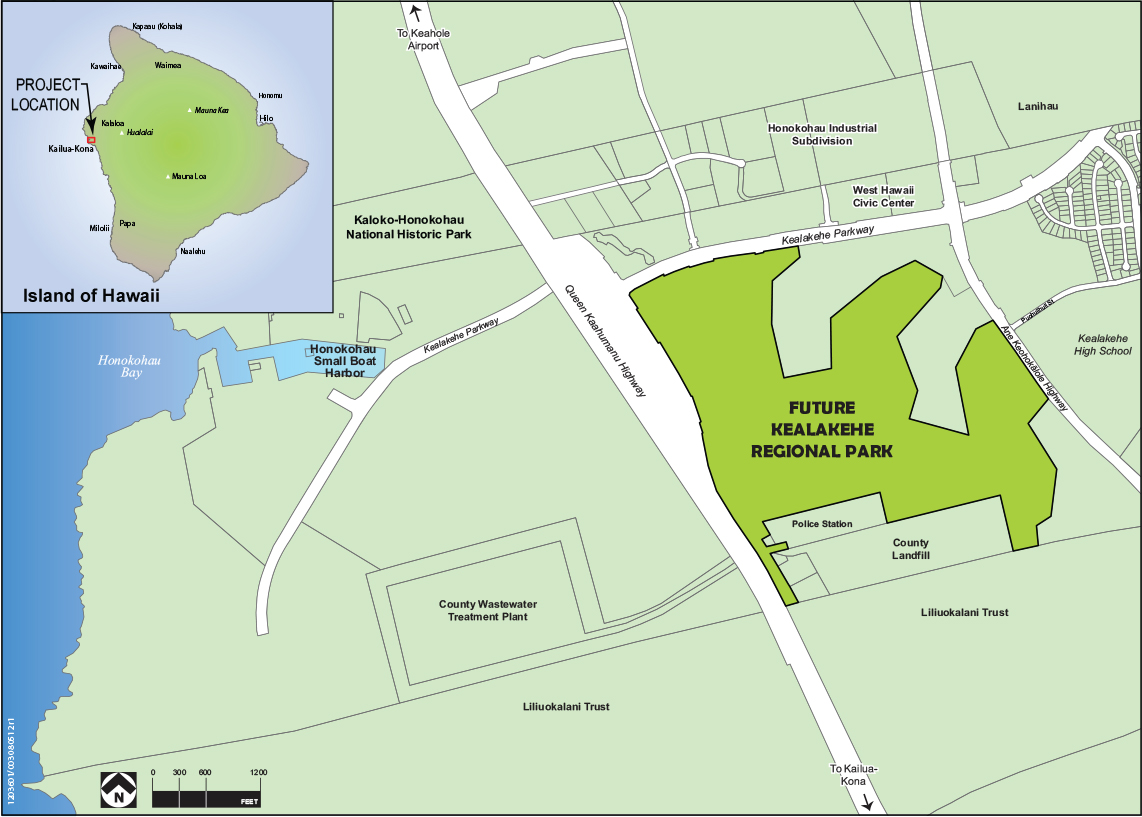Introduction
Purpose
The County of Hawai‘i Department of Parks and Recreation and the West Hawai‘i Parks and Athletic Corporation (WHIPAC) have prepared this master plan for a proposed regional park at Kealakehe. The Kealakehe Regional Park is envisioned to be a focal point for organized sports and outdoor recreation, a landmark, and a community gathering place for this rapidly growing region of Hawai‘i Island.
The scope of work for the master plan included an assessment of existing conditions at the site, an evaluation of the opportunities and constraints they posed, development of project goals and objectives to frame and focus the future design, and the creation of alternative land use plans with cost estimates to determine what was most appropriate for the property. A three-day charette workshop was conducted to engage the community in finalizing a preferred plan. Throughout the planning process, a steering committee comprised of members of the non-profit West Hawai‘i Parks and Athletic Corporation (WHIPAC) provided valuable guidance in developing the plans and gathering community input.
The project area, identified as Tax Map Key: (3) 7-4-020:007, is approximately 190.5 acres and is bound by Queen Ka‘ahumanu Highway on the west (makai), Kealakehe Park – way on the north and Ane Keohokālole Highway on the east (mauka). The southern property boundary is shared by Queen Lili‘uokalani Trust land, the County landfill and the Kealakehe Police Station. Once proposed as a golf course, the project area is irregularly shaped with finger extensions originally designed to accommodate golf fairways. Within this superblock, other parcels of land are owned by the State of Hawai‘i Housing and Finance Development Corporation (HHFDC) and the Department of Hawaiian Home Lands (DHHL).

Project Background

For almost 30 years, development of a regional park for the community to enjoy was envisioned for the barren lava lands of Kealakehe, on the western slope of Hualalai. In 1985, the current project area was proposed for the Kealakehe Sports Complex complete with gym, swimming pool, tennis courts, martial arts arena, concert hall, exhibition hall, equestrian ring, soccer field and archery range. Five years later, in 1990, plans were revised and the land was proposed as an 18-hole public golf course, as part of the larger Kealakehe Planned Community. The 800-acre Kealakehe Planned Community, proposed by the State Housing Finance and Development Corporation, was envisioned as a mixed-use master planned community which would include housing, recreational uses, schools, public facilities, commercial areas, and a public golf course to be developed by the County. The entire Kealakehe Planned Community was linked to the Kealakehe Wastewater Treatment Plant (WWTP), which was constructed around the same time on the makai side of Queen Ka‘ahumanu Highway.
The intent was for treated effluent from the WWTP to be used to irrigate the future golf course.
The current 190.5-acre project area encompasses the lands that were formerly set aside for the golf course, which was never built, largely due to changing economic conditions. After sitting idle for over 20 years, in January 2011, Governor Neil Abercrombie issued Executive Order 4355 which set aside TMK (3) 7-4-020:007 for “public uses and purposes” for the “Kealakehe Wastewater Reclamation Field, North Kona Golf Course and/or public park under the management and control of the County of Hawai‘i.” The County subsequently engaged the firm of Kimura International Inc. in July 2012 to prepare a long range master plan for a proposed regional park at Kealakehe.
In July 2012, a community based, non-profit, 501(c)(3) corpo- ration, calling itself the West Hawai‘i Parks and Athletics Corporation (WHIPAC), was established and organ- ized to “provide the residents of West Hawai‘i recreational facilities and open spaces for social, educational, sports and health program and services; and to plan, design, and construct recreational facilities for West Hawai‘i communities.” The group consists of community leaders, businesses, organized sports leaders and other caring residents. WHIPAC founders were instrumental in working with the County to initiate the master planning effort, and these individuals served as a Steering Committee during the planning process. During the planning process, the planning team met with the WHIPAC Steering Committee more than five times to obtain their guidance and feedback on the objectives and program. WHIPAC members also helped disseminate information to the community about the planning effort, and gathered community input.